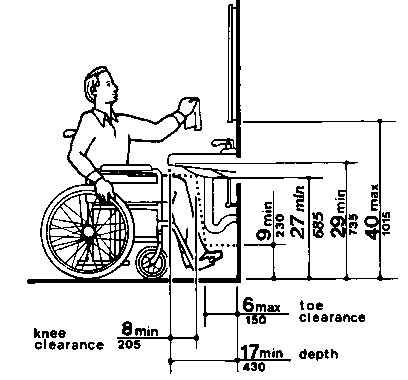
In 1968, the Architectural Barriers Act (ABA) was passed, paving the way for the subsequent passing of the Americans with Disabilities Act (ADA) in 1990. The Architectural Barriers Act required that facilities that are designed, constructed, altered, or leased with particular federal funding, be accessible to people with disabilities. The law even included non-governmental facilities that are given federal funding; certain schools, public housing, and systems of mass transit. According to the United States Access Board, The ABA stands as the first measure by Congress to ensure access to the built environment for people with disabilities. Standards set forth by the Architectural Barriers Act of 1968 are those that govern architectural and facility design standards of today. U.S. Post Offices, Veterans Affairs medical facilities, national parks, Social Security Administration Offices, federal office buildings, U.S. Courthouses, and federal prisons are all subject to the architectural and design standards of this law.
Following the passing of the Architectural Barriers Act, the United States would implement standards and laws that would further ensure the inclusion of people of diverse abilities in facility design planning. Following are some of the most important standards and laws that were a consequence of the enactment of the ABA in 1968 and, subsequently, the ADA in 1990:
- 1998: Uniform Federal Accessibility Standards (UFAS) Presents the standards for the design, construction, and alteration of buildings to accommodate people with diverse mobility needs, in accordance with the standards set forth by the ABA.
- 1988: Fair Housing Amendments Act (FHAA) Amendment to the Civil Rights Act of 1968. The FHAA extended discrimination protection to people with disabilities and families with children with disabilities, as the Civil Rights Act did so for discrimination of people on the basis of color, race, religion, sex, or national origin.
- 1991: Fair Housing Accessibility Guidelines The guidelines for Department of Housing (DOH) and Housing and Urban Development (HUD) that provides guidance to builders and developers on how to comply with the accessibility requirements set forth by the FHAA.
- 1998-2008: ADA Accessibility Guidelines Amendments. During this time period, amendments were made to the guidelines so as to include guidelines for state and local government facilities (standards for new construction and alterations of state and local governments facilities protected by ADA), play areas (including new construction and alterations to existing play areas), and recreation facilities (including guidelines for areas such as amusement rides, boating facilities, golf courses, and swimming pools).
- 2002: Help America Vote Act Reform to the United States’ voting process. Funding was provided to states to make polling facilities accessible, and make available voting systems accessible, to people with disabilities (including non-visual accommodations).
- 2005: S. Postal Services (USPS) Standards for Facility Accessibility The USPS updated their policies to be in compliance with standards set forth by the ADA
- 2006-2010: S. General Services Administration (general commitment to accessibility), Department of Justice, Department of Transportation (bus stops and stations and rail stations), and Department of Defense all implement of ABA & ADA facility design standards into their policies.
- 2014: U.S. Access Board ABA Accessibility Guidelines and U.S. General Services Administration (GSA) Architectural Barriers Act Accessibility Standard updated to include new provisions for Outdoor Developed Areas on Federal land. Outdoor developed areas include trails, picnic and camping areas, as well as beach access routes.
